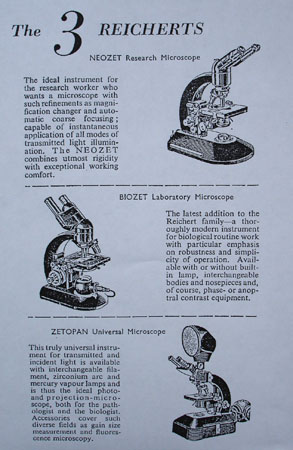
Notes & Comparisons.
By Ian Walker. U.K.
Introduction.
This article is not supposed to be a comprehensive review of either the Zetopan or Neozet but rather notes on compatibility of accessories and differences between the stands and general comments on usability. The Zetopan had a good life in many labs, although I don't think it was as popular here in the U.K as Zeiss or Leitz models but in mainland Europe and the U.S.A. it was likely more common. The Zetopan went through various colour changes from black, silver and cream with a few shades in between whilst the black Neozet never was as popular as its bigger sibling and faded out of existence. Both started in the mid 20th century and the Zetopan continuing for a good many years but for the Neozet, as far as I know, it only had a fairly short life from its introduction in the 1950's.

Fig 1.
An early publicity document showing the 'Zetopan Universal', 'Neozet Research' and its baby brother the 'Biozet Laboratory' the latter which according to flyer had options for either an external or built in lamp. The external lamp assembly sat on the base like some of the Lomo range and Vickers. The build quality throughout of the Zetopan and Neozet is very good with excellent finish of both enamel and tooled surfaces.
The Zetopan is well documented today with a good archive on the Web of manuals, objectives and accessories, this is a different story for the Biozet and Neozet both of which there is scant information today except for single pages like the above. The Zetopan being not as popular as Zeiss or Leitz can be purchased from time to time on eBay and occasionally dealers, the prices are usually reasonable for the quality of build but there are some issues which I will discuss later, regarding the other two they rarely seem to come up for auction or appear elsewhere.
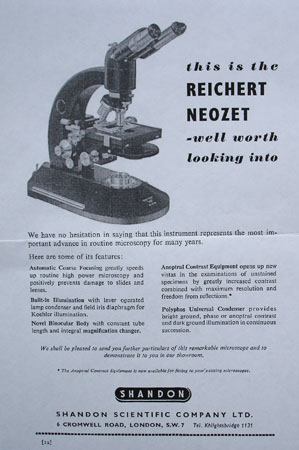
Fig 2.
Shandon Scientific Co Ltd. seem to have been the main importer for the U.K, in this advert a short summary of its virtues are listed including automatic focus [debatable], built in illumination and the Polyphos universal condenser [very rare] which is a direct equivalent of the Leitz Heine condenser for which the operation is well documented today as an excellent Leitz manual is still available to download. Both of these operate on exactly the same principle where continuous adjustment for different phase objectives without the need for different annuli on a turret with the benefit for also obtaining darkfield illumination and annular brightfield too up to a limit. This condenser can also be used with the Zetopan. I think the extra complications of the limit stops on the focus and rather unusual binocular head could have been the Neozet's downfall compared to the standard construction techniques of say the Zeiss Standard GFL, WL and Universal and Leitz Dialux which will have been its main competitors of the period.
Overview.
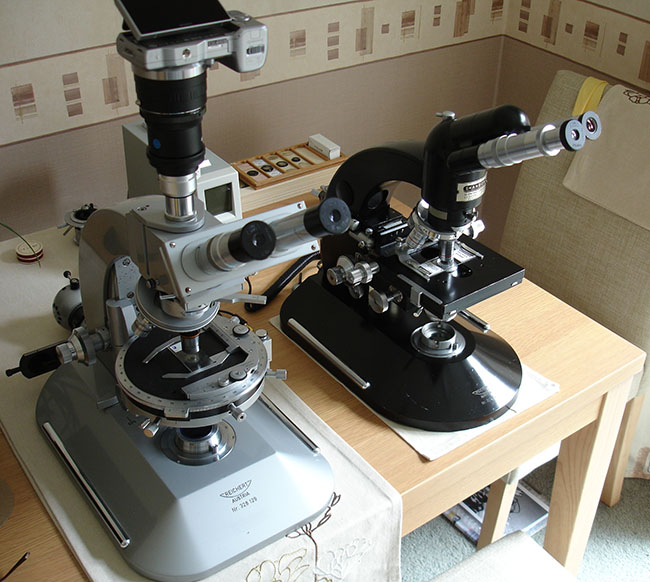
Fig 3.
Here we can see the silver Zetopan of a later period and black Neozet side by side for comparison. The bases are not dissimilar and both can take a riser attached to chrome side bars to allow high power lamps to be used for fluorescence work. They stand roughly the same height with the Neozet slightly lighter frame work on the limb and base. Both can take epi illumination accessories but they are of different design and not compatible as the Zetopan is illuminated from below using the key switch on the base to direct light up and the Neozet has removable caps in the limb where a tubular light is inserted and lit from behind.
My Zetopan has the rather rare full polarizing stage assembly fitted, a sophisticated and very heavy unit with the optional mechanical stage controls also present. The stage and condenser carrier are quick release on the Zetopan, the stage is not normally removable on the Neozet although the substage can be removed to allow the stage to be lowered by a control below the right course focus control to allow epi illumination.
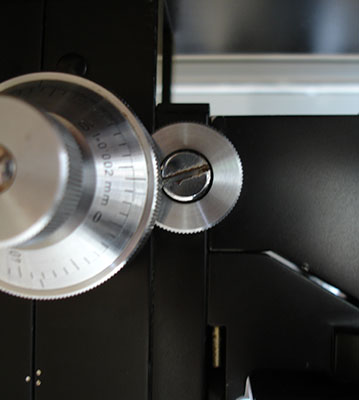
Fig 4.
Control for releasing the substage. Notice the 0.002 mm/div fine focus, this compares to the Zetopan 0.001 mm/div. Both the fine focus and coarse are a delight to use on both stands with good weighting, smooth damped operation and counterbalanced coarse focus.
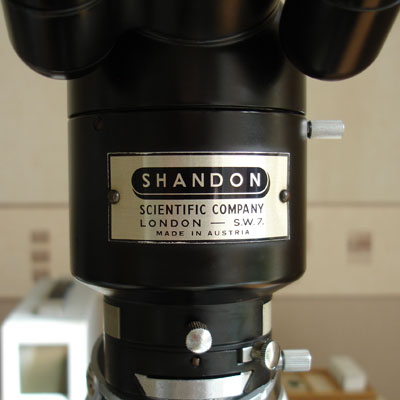
Fig 5.
Shandon Scientific Company logo proudly attached to the tube assembly.
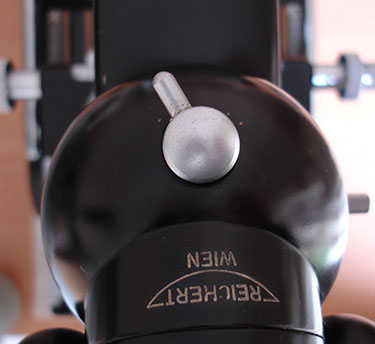
Fig 6.
The two position optovar seen on the top of the Neozet, no information is available to suggest the magnification factor but the higher setting seem to be about 1.5x the normal but on my scope the image suffers in contrast significantly when selected. This facility is not available on the Zetopan but in its favour is the standard photo port, continuously variable rotation side to side of the binocular assembly which is smooth mechanical not frictional and swing in Bertrand lens [seen on later models only].
The photo port with eyepiece fitted is not parfocal with the binocular eyepieces on my scope, this is most obvious with low power objectives which have to be re-focused from their usual position getting worse as you approach 2.5x. The photo port was originally intended to be used with a special photo block together with complex 19" rack exposure module and 35mm camera back and probably had some sort of correction lens system. At present a Sony NEX 5n camera body is fitted via an adapter which gives fairly good results on the whole. I have not found DSLR's to work well with any combination of adapters or eyepieces I have to hand. The Sony NEX can also be used in one of the binocular tubes on the Neozet via a C mount to NEX adapter but the capture area is not optimal and abandoned.
Repairs.
On my sample the Zetopan trinocular head assembly gives superior contrast to that of the Neozet, the latter of which was in nearly unusable condition on receipt with washed out images and little definition. This is a novel but complex construction, the optovar lens system adding even more complication. After the top central screw dust cap is removed a spring clip holds the individual eyepiece tubes in place, everything can be dismantled right down to prism level which for once are easy to remove and replace after cleaning and keep in collimation due to rigid castings holding them in place. Everything accessible was cleaned and re-assembled and final collimation with eyepiece graticule and micrometer slide, the dirt and fungal deposits are some of the worst and stubborn to remove I have seen but thankfully it all came good, but due to the difference in age the later serial number Zetopan has the edge for contrast by some margin probably aided by better lens coatings.
No major servicing was needed on the Zetopan except for some new lubricants and very stiff operation of the flip out top on the 2 diaphragm condenser which was due to solid dried out lubricant. Collimation on the binocular head is excellent and needed no adjustment and the stage feels like new.
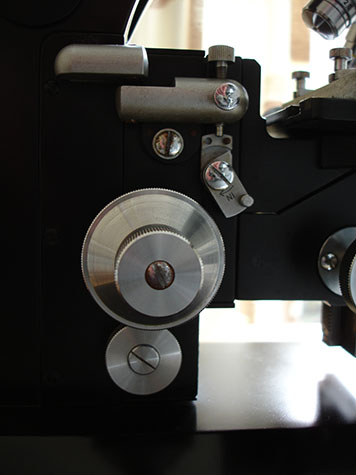
Fig 7.
Neozet ... automatic coarse focus the brochure says, appears to me to be no more than an upper and lower stop on the coarse focus which limits its travel, it could be useful but to me just adds unnecessary complication and is not required and is seen disengaged. Modern automatic coarse focus could be very useful for labs', here the stage can be pushed down by hand against a light spring, a new slide inserted and then the stage returns to a stop pre-defined before use where the focus is required saving a lot of time for busy operators. The control below and just behind the course focus sets tension and prevents focus slip.
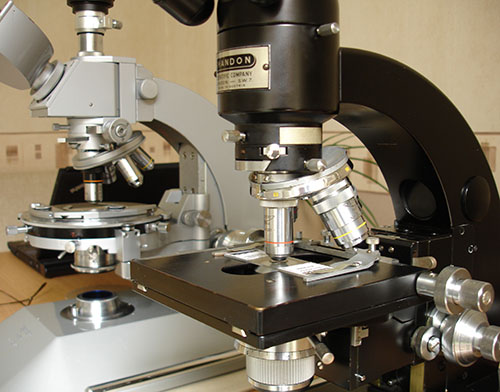
Fig 8.
Another overview of the stands giving a better impression of the limb design, they are not dissimilar, as in Fig 4 we can see the release knob on the RHS of the Neozet to allow substage removal. just above the X Y stage controls we can see a rather rusty lever at stage height, this releases the stage which can then be preset at a height both up and down of its normal position. Fitted to the Neozet is the rare Polyphos condenser for phase and darkfield but less useful for brightfield work as this can only be achieved by the circular illuminating ring of light rather than standard Köhler illumination.
Note, both have dedicated analyzer and retarder slots, the polarizer and analyzer plus retarder can be seen fitted to the Zetopan and dust caps on the Neozet. The retarder slider is compatible for both stands. The dust capped aperture for epi illumination in the limb can be clearly seen on the Neozet. Both the Zetopan and Neozet have removable nosepieces.
Both the polarizer and analyzer on the Zetopan are rotatable and graduated. These are not compatible with the Neozet, neither fit correctly as the Neozet analyzer slot is too deep and wide and the base fitting is incorrect to take the snap-on Zetopan polarizer. It is this sort of incompatibility that would have annoyed labs, compare this to Zeiss and almost universal compatibility of parts from one stand to the next of this period.
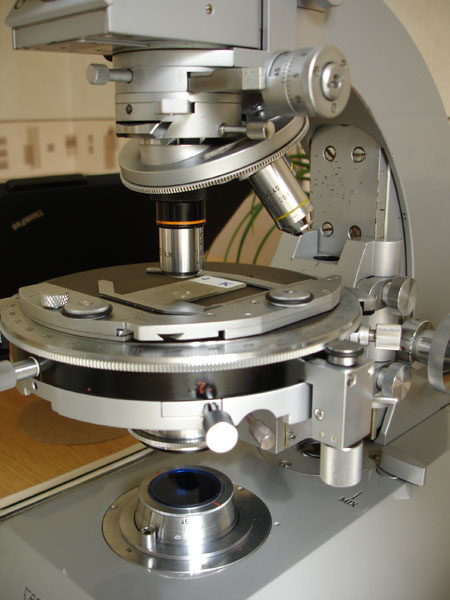
Fig 9.
Fig 9. shows a good overview of the Zetopan rotating stage, polarizer, analyzer and retarder. Heavy duty quick release controls seen on the right allow for repositioning and removal of the stage and removal of the substage. Low slung X Y stage controls are seen, I have added rubber 'O' rings to allow more comfy grip as they are a bit small and fiddly in use. The stage is a work of art, it has an excellent hard wearing matt surface and has the benefit of slow motion rotation by the knob seen on the right, this can be disengaged from the stage if required by lever. Very precise verniers are fitted and full ball bearing operation of the stage bearings allows light control. There are user defined click stops available to preset where ever you wish but normally aligned to the vernier for 0, 45, 90 degrees etc You can see on the base a lever marked 'mix', this is for a mix of transmitted and epi illumination but normally left in transmit position. To make this a fully operational polarizing stand the dedicated strain free monocular tube would be needed.
Objective range.
This period for Reichert used RMS pre-DIN objectives, two different styles can be found depending on vintage the latter ones having a more modern simpler appearance. Unlike Zeiss and Leitz of this era Reichert's range seems a bit limited, there are few fluorite's and no apochromats to be seen in the line-up. Semi-plan and plan were available both in phase, anoptral and none phase variants with the usual 2.5x to 100x limits being the norm for the none phase. A good number of special epi objectives completed the catalogue. Some examples of typical objectives can be seen on both turrets in the overview photo's although in Fig 9. a temporary Zeiss 6.3x plan is in use for observation of O.U. thin rock section with an anoptral phase 20x seen to the right.
Illumination.
Zetopan.
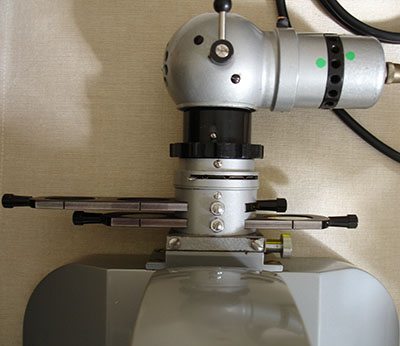
Fig 10.
The lamp assembly for the Zetopan uses a 30 watt tungsten lamp, the alternative high power 100 watt differs in being rectangular and uses a halogen bulb. True Köhler illumination is available by a swing out frosted glass in front of the bulb whilst a further blue frosted filter provides colour correction, this is part of the filter sliders which include green and neutral density or nothing selected in centre position. In Köhler operation there is rather too much colour fringing from the bulb filament for my liking but the efficiency is way better with far more light output compared to swinging in either of the frosted filters. A curved mirror behind the bulb helps to even out the open filament construction of the bulb. The bulbs are hard to come by, my brother managed to source 2 new old stock original Reichert bulbs in the U.K, no bulb was fitted on receipt so I have one spare but always using the supply from 0 volts and winding up the volts should give a good life and current limiting on the p.s.u. can prevent over voltage.
Unlike later Zeiss and Leitz lamp assemblies with several tweaks to obtain the most accurate and even illumination this is rather crude by push pulling the bulb holder and twisting. A variable condenser lens can be used for optimal evenness of field together with a field diaphragm when the 2 diaphragm Berek style condenser is not used. The whole assembly fits on a quick release substantial dovetail at the rear of the base.
Neozet.
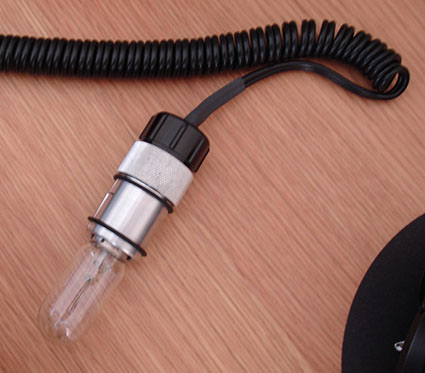
Fig 11.
The above picture shows an old Lomo lamp assembly including an original 9 volt 15 watt Russian lamp with rounded front, later 6 volt Philips replacements tend to be square fronted. This rounded front is important as it can snugly fit next to the curved frosted condenser lens in the base [similar to the Wild M20]. From a picture of an original Neozet lamp assembly part of an eBay sale recently this is a close match. The rubber 'O'' rings are to accurately centre the tube in the base port as the Lomo is smaller diameter. The original lamp was missing from the stand but this works pretty well and provides just enough light for most purposes on the Neozet.
Power.
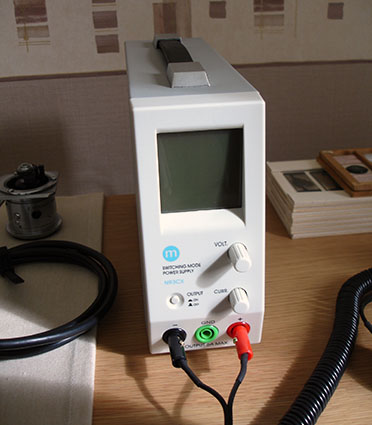
Fig 12.
A modern light weight general purpose switch-mode 5 amp regulated power supply with variable voltage output and current limiter can be used for both the 6 volt 30 watt Zetopan bulb and lamp assembly for the Neozet, the latter of which I guess would have been probably 6 volt 15 or 20 watt. Original power supplies for both stands were missing. Compared to the heavy bulky transformer based power supplies of the period which often hum loudly this type of supply is totally quiet and a pleasure to use and barely weighs more than a kilo plus added benefit of digital display of voltage and current.
Condensers.
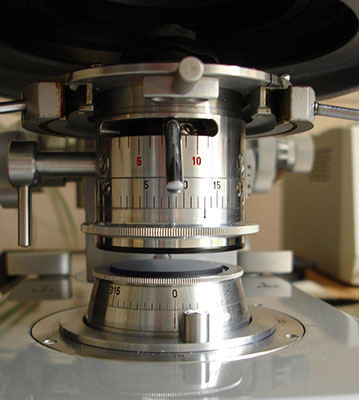
Fig 13.
The usually supplied 2 diaphragm [Leitz Berek style] 0.95 swing out top, probably achromatic. I have never been able to get the full numerical aperture out of this condenser as stated which remains a mystery. Compatible with both the Zetopan and Neozet. np written on these condensers means strain free and originally cost nearly double the normal variety. np on objectives also mean they are strain free. The np condenser does provide better cross-polar extinction compared to the normal as I have one of each.
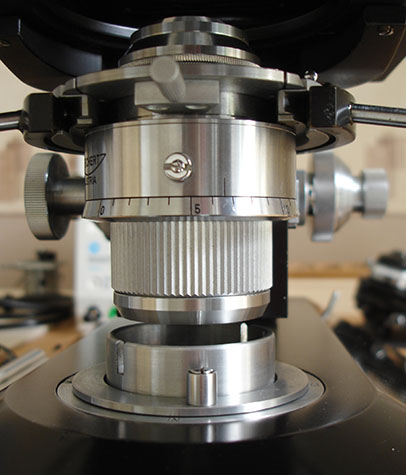
Fig 14.
Polyphos condenser suitable for phase, anoptral and darkfield with a poor brightfield option, lowered here for better view. Anoptral contrast is an alternative to Zernike style phase contrast but the objectives tend to have the annulus further out as seen looking at the rear of the objective. The phase ring on the yellow banded anoptral objectives, [red bands for phase contrast] differ in that it is of different material deposit on the glass to that of phase objectives this gives a light brown background rather than the grey. Excellent resolution is possible and the 40x n.a. 0.65 achromat easily resolves the striae on Pleurosigma angulatum which is normally obscured on the same n.a. phase objective.
The anoptral contrast system is peculiar to Reichert. The condenser large rotating control surface is a pleasure to use with a smooth damped feel, good darkfield is obtainable on low power objectives. The alloy control rod on the base of the stand swings through 90 degrees and brings in either a lens or plain glass, these rotate on an enclosed turntable directly in front of the mirror which is included in the mechanism, the whole assembly is easily removed from the base for cleaning. The optics selected depends on the condenser and is used in conjunction with a field diaphragm at the back of both scopes when the Berek style condenser is not in situ, this system is used on both stands although in different formats. I have used this condenser with Zeiss objectives, the 25x n.a. 0.6 and 40x n.a. 0.75 Neofluar give superb results and unlike a Leitz Heine I have used in the past, gives a much broader illumination ring which is variable in width to some extent depending on how the substage height is varied. An excellent condenser!
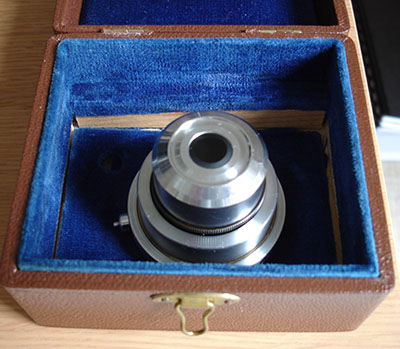
Fig 15.
Darkfield condenser in original felt lined case, normally oil immersed with n.a. 1.18-1.40, can be fitted to both stands, here shown without the metal plate fitting to be used with the substage carriers, this is just a friction fit plate. As is, this fits some of Reichert's other stands further down the pecking order.
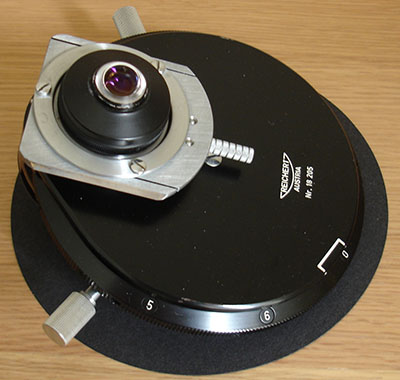
Fig 16.
Standard turret condenser with 2 variants. This 0.98 top and a long working distance version with lower n.a of 0.6. I have never achieved the stated n.a. and appears to be of Abbe construction. The condenser is shown with the correct clip-on fitting for both the Zetopan and Neozet substages. Several positions including brightfield setting with iris and some empty apertures, can be used with both anoptral contrast and standard phase objectives. Later ones could be found in grey metallic paint to match my Reichert. Caution has to be used as occasionally you will find a combination of later objectives and earlier condensers like this black one where the phase annuli don't match as is the case with a 25x anoptral objective I have. Below the condenser is a swing in correcting lens for low power work when used with the Zetopan. This condenser seems mis-matched with the Neozet although one looking very much like is seen in the brochure.
Epi illumination.
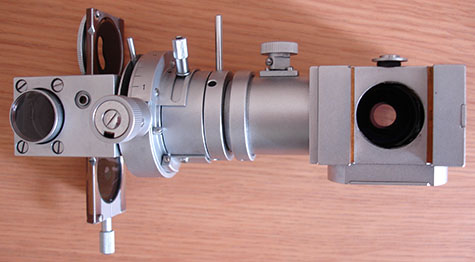
Fig 17.
The Zetopan epi illumination assembly seen from underneath. light enters in through the left hand lens, normally special epi objectives have to be used, these have a fixed carrier plate to push into the dovetail, I got round this and can use any RMS objective on a home made Perspex carrier assembly. This Zetopan epi system as stated before is incompatible with the Neozet which has its own system.
Conclusion.
Both these microscopes are of excellent quality, if I had to choose one it would be the Zetopan as they are more abundant, the photo port is useful together with better documentation and accessories available. The Neozet being of the same research grade should use the same accessories as its bigger brother in my opinion and its downfall, against the opposition at the time from Zeiss and Leitz, users may have preferred them over the Neozet and I think the autofocus mechanism over complicates the mechanics and is unnecessary.
Comments to the author Ian Walker are welcomed. I would be very interested in obtaining further resources on the Neozet, in particular the manual and brochures. Also a manual for the Polyphos. Editor's note added August 13th 2017. Ian no longer has the stands described so the information request is now void. He is also not able to help with queries on such stands, now having no hands-on access to them.
Resources:
Gordon Couger's excellent website www.science-info.net hosts manuals for the Reichert Zetopan including the microscope, objectives and accessory range.
A splendid image of the Reichert Biozet with external lamp, the Polyphos condenser and trinocular head is illustrated on 'George's Microscopy Pictures' website.
A large example of the Shandon advert shared above for the Reichert Neozet is available in Quarterly Journal of Microscopical Science, September 1956.
Acknowledgements: Thanks go to David Henderson for supplying an eBay auction image to me of a Neozet including lamp house which was very useful for ascertaining lamp design and also for a scan of the leaflet 'The 3 Reicherts' Neozet, Biozet & Zetopan' shared above.
Published in the September 2012 edition of Micscape.
Please report any Web problems or offer general comments to the Micscape Editor .
Micscape is the on-line monthly magazine of the Microscopy UK web site at Microscopy-UK
©
Onview.net Ltd, Microscopy-UK, and all contributors 1995
onwards. All rights reserved.
Main site is at
www.microscopy-uk.org.uk.